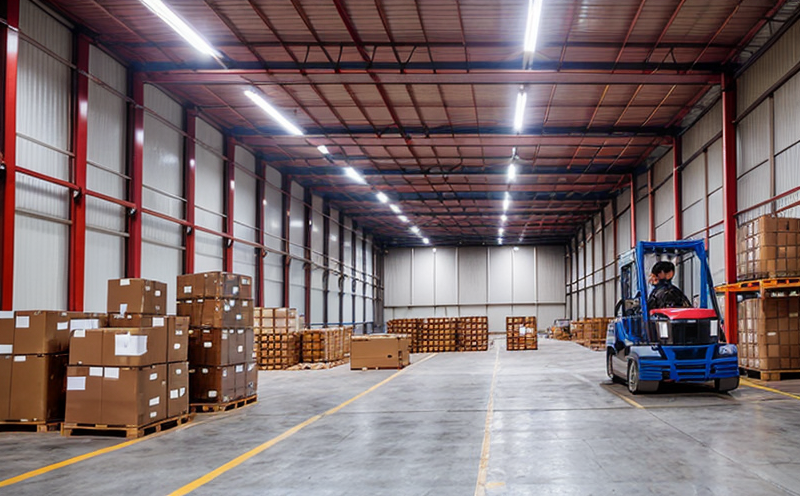ISO 2879 Packaging Stability Testing under Load
The ISO 2879 standard is a critical component in ensuring that packaging designs are not only aesthetically pleasing but also robust and functional. This service focuses specifically on the stability of packaging materials when subjected to loads, which is essential for maintaining product integrity during transportation and storage. In industrial manufacturing and processing, where logistics play a significant role, it’s crucial to assess how different packaging designs will behave under real-world conditions.
Understanding that load-induced stress can lead to compromised package performance, ISO 2879 provides guidelines for testing the stability of packaging materials under dynamic loading scenarios. This ensures that manufacturers and suppliers can confidently present their products to the market without worrying about potential damage during transit or storage. Compliance with this standard is particularly important in industries where product quality is paramount, such as pharmaceuticals, electronics, and food & beverage manufacturing.
The testing process involves placing packaging specimens under specified loads, simulating real-world conditions that packages might encounter during transportation. The aim is to observe how the package deforms or fails under these stresses, thereby identifying any weaknesses in design early on. This proactive approach helps companies improve their product offerings and enhances overall supply chain efficiency.
When performing ISO 2879 tests, it's vital to ensure that both the testing equipment and personnel are up-to-date with the latest standards. Our laboratory adheres strictly to best practices as outlined in ISO 2879, ensuring accurate and reliable results every time. The test setup typically includes a robust load frame capable of applying precise controlled loads onto various types of packaging materials.
The specimen preparation for these tests is critical; it involves selecting appropriate samples that represent the intended product packaging accurately. Factors like material type, shape, size, and anticipated environmental conditions all influence how specimens are prepared before being subjected to load testing.
| Parameter | Description |
|---|---|
| Type of Load | Determines the specific force applied based on industry requirements. |
| Testing Environment | Controls temperature, humidity levels to simulate real-world conditions. |
| Specimen Preparation | Involves cutting and shaping packages according to ISO 2879 guidelines. |
The load application process is carefully monitored using high-precision instruments that measure deflection, stress distribution, and other relevant parameters throughout the test. This allows us to generate comprehensive reports detailing the performance of each specimen under various loading conditions.
Compliance with ISO 2879 ensures not only better quality control but also helps companies stay ahead in terms of regulatory requirements. By incorporating these tests into their R&D processes, manufacturers can continually refine their packaging designs and meet customer expectations more effectively.
Applied Standards
The ISO 2879 standard is widely recognized for its role in ensuring robust packaging design across numerous industries. It provides a framework for testing the stability of packaging materials under load, which is essential for maintaining product integrity during transportation and storage.
- ISO 2879-1:2005 - Packaging - Determination of resistance to stacking loads
- ISO 2879-2:2013 - Packaging - Determination of resistance to stacking loads for rigid containers
These standards are integral in ensuring that packaging meets the necessary performance criteria, thereby enhancing overall product quality and safety. Compliance with these guidelines is particularly important when dealing with fragile or sensitive products such as electronics or pharmaceuticals.
Scope and Methodology
The scope of ISO 2879 Packaging Stability Testing under Load encompasses various aspects related to the stability assessment of packaging materials subjected to dynamic loads. This includes evaluating how different types of packaging behave under specified conditions that mimic real-world transport scenarios.
- Testing Setup: The test setup involves configuring a load frame capable of applying controlled forces onto specimens representing actual product packaging.
- Specimen Preparation: Proper preparation ensures accurate testing results. This entails cutting and shaping packages according to ISO 2879 specifications.
- Loading Process: Controlled application of loads simulates typical transport conditions, allowing for detailed observation of package behavior.
The methodology used follows closely with the procedures outlined in relevant sections of ISO 2879. Our laboratory employs advanced instrumentation and software to monitor key performance indicators during testing, ensuring precise and reproducible results.
Environmental and Sustainability Contributions
- Eco-Friendly Packaging Design: By identifying potential weaknesses early in the design stage through rigorous testing per ISO 2879 guidelines, manufacturers can optimize their packaging to minimize material usage while maintaining structural integrity.
- Energy Efficiency: Efficiently designed packages reduce fuel consumption by minimizing dead weight during transportation. This contributes positively towards reducing carbon footprints associated with logistics operations.
Incorporating ISO 2879 into your quality assurance protocols not only enhances product safety but also supports sustainable business practices. Through thoughtful packaging design, companies contribute to a greener environment by optimizing resource utilization and minimizing waste generation throughout the supply chain.





